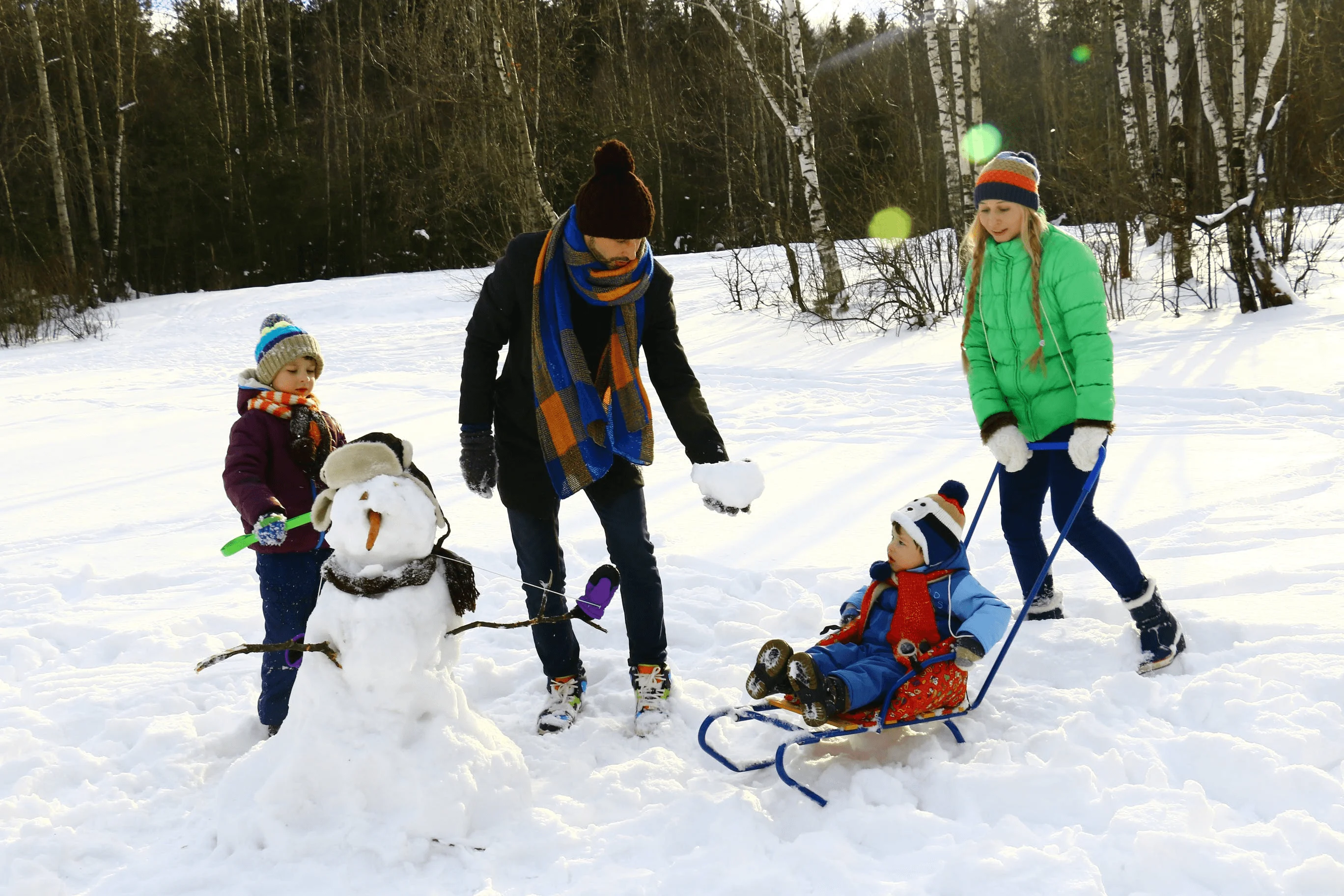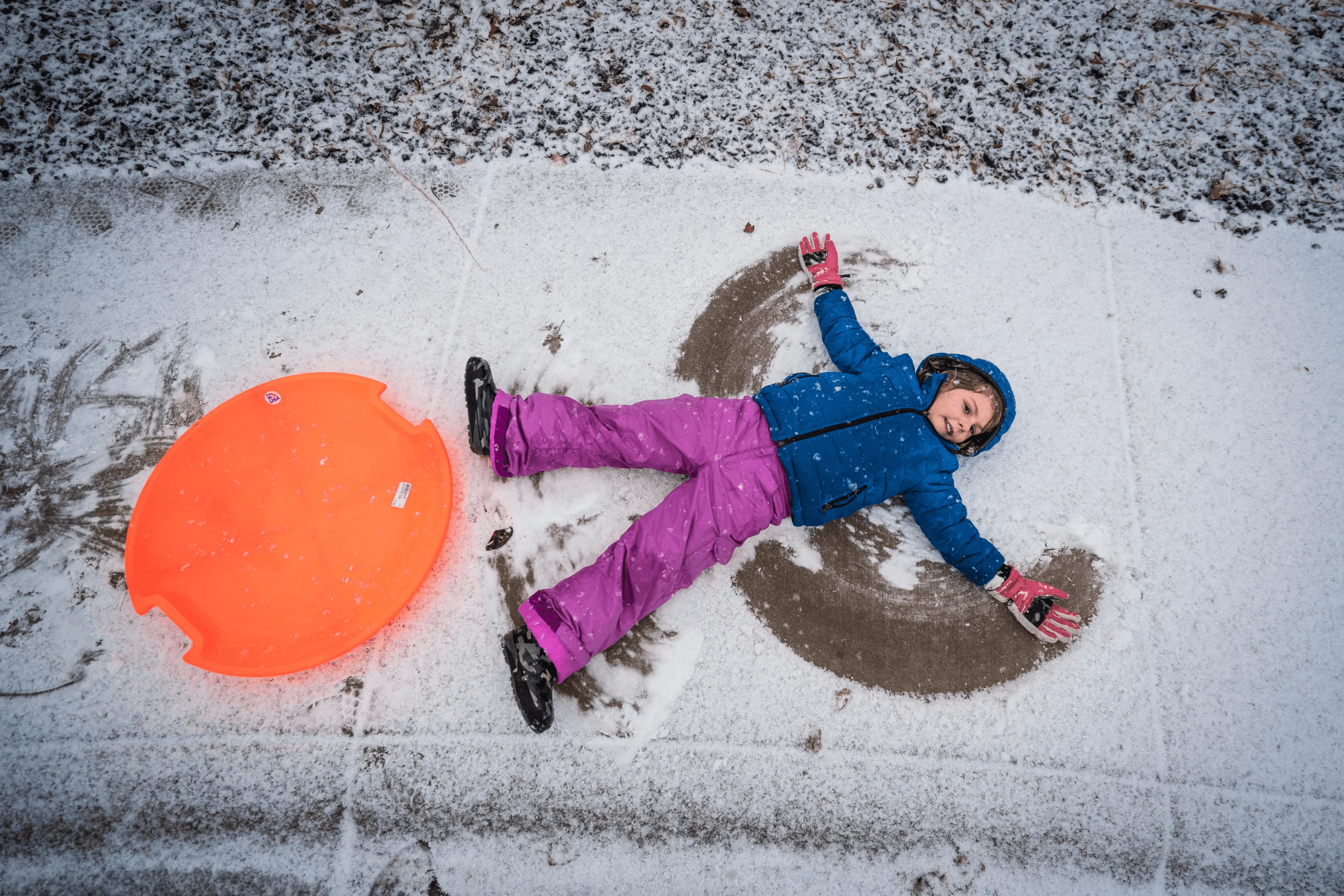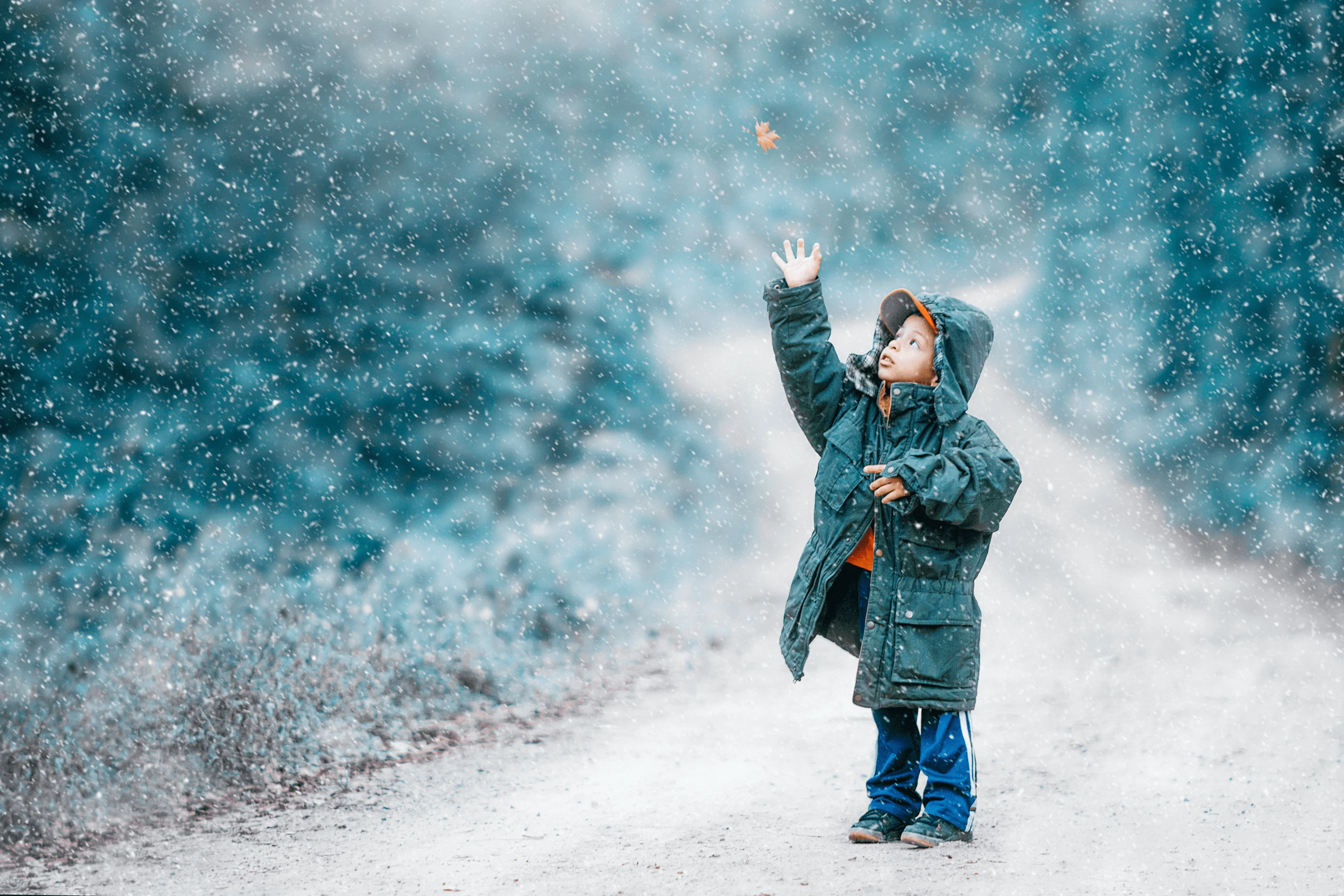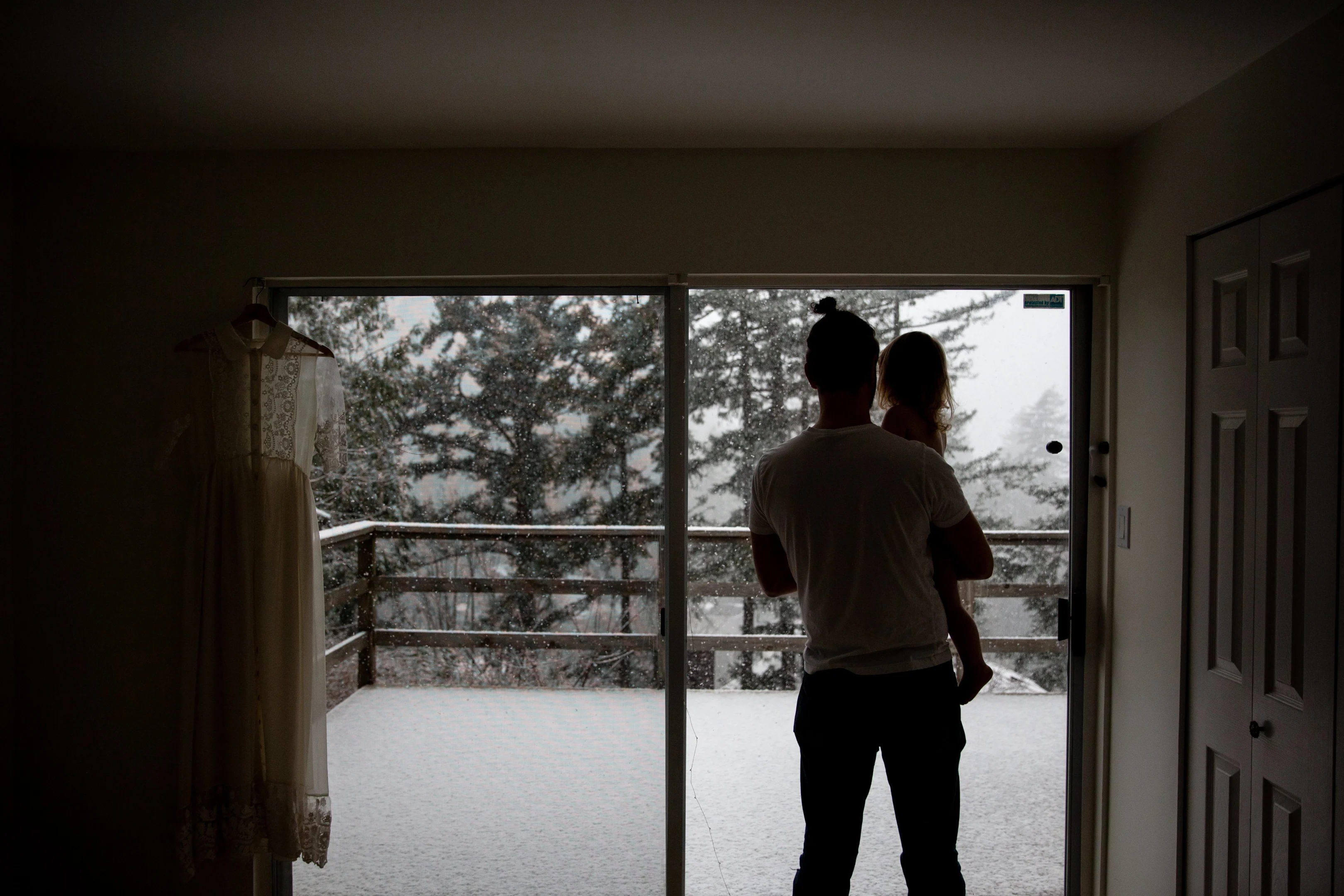
If you are lucky enough to live in a part of the world that has the wonder of occasional snowy days, seize the moment (and the children) and get outdoors to make the most of the experience. There is something magical about waking up and opening the blinds to a world that has secretly and softly turned into a white wonderland overnight.
Playing in the snow will create many moments of awe and wonder, but there are plenty of other benefits too:
The extra calories needed to cope with the cold weather mean children will build up healthy appetites for their next meal.
Playing in the snow means plenty of physical energy is used.
Physical skills like balance and coordination will happen naturally as the children navigate moving around in a slippery new world.
Playing outside in a world that has turned white fires up the imagination. It will stimulate children’s imagination and improve their language skills. There is no substitute for real-life experience.
If you ask most adults for their favorite memory of childhood, it is almost always a memory of being outdoors in nature, so playing in the snow will create lifelong memories.
So, before you go back inside cold, tired and ready to curl up with a hot chocolate and watch the best snowy day movie, try the activities below:
1. Magical Mark Making
A fresh fall of snow is great for some free play, but there are also lots of ways to use the snow to learn.
Give the children a stick or twig and ask them to make marks in a fresh patch of unmarked snow.
Try:
Writing your initial
Writing simple sums
Drawing shapes
2. Amazing Winter Art
Art and craft work can still happen in lots of ways outdoors, never more so than on a snowy day.
Provide a selection of:
Water pistols
Spray guns
Spray bottles
Old perfume bottles
Syringes/pipettes
Recycled plastic bottles with caps (like old washing-up liquid bottles)
Mix up a solution of food coloring and water. You will need the color to be as strong as possible. Fill a selection of containers with the colored water solution, and encourage the children to spray the white snow to make patterns and pictures with the different colors. As the snow melts, the colors will blend.
Take plenty of photographs of the snowy day artwork.
3. Bringing the Snow Inside
To follow up the above activity inside, fill several containers with a colored water solution and put them in the freezer. Allow them to freeze solid overnight. Make as many different colored ice blocks as you can. Try filling:
Baking trays
Muffin trays
Recycled containers e.g. margarine and yoghurt
Plastic beakers
Lolly/popsicle makers
If there is snow on the ground and you don’t have much room in your freezer, you can freeze the containers by leaving them outdoors overnight, as long as the temperature is below zero degrees.
When the colored water has frozen solid, turn the frozen colored ice blocks onto the snow to make pictures, shapes, and patterns or use the shapes to build letters and numbers. You can also use ice pops to add to your patterns.
4. Bulls-Eye-Ice
An alternative to the fun idea above is to use the ice blocks as targets.
Place the colored ice blocks in a row. This could be either on a wall or on the ground. Encourage the children to make snowballs by squeezing a handful of snow in their hands and rolling it around.
Throw the snowball at the colored ice to score points. For example:
Pink – 1 point
Blue – 2 points
Orange – 3 points
If you just have a sprinkling of snow and there isn’t enough to make snowballs, try using water pistols to shoot the targets (Use warm water).
5. Save the Snow
When you have finished playing outdoors, make a few extra large snowballs and bring them back indoors. Leave them in the freezer overnight and bring them out the next day. Ask the children to notice what, if anything, has changed about the size and shape of the snowballs.
Talk about what will happen if we put the snowballs in a warmer place than the freezer, for example on a windowsill or a table near a heater.
How long do the children think the snowballs will last? Record their predictions to see who is closest. Set a timer and leave the snowball on a tray or in a bowl. When it has completely turned to water, check the time to find out who made the best prediction.
6. Exercise? Snow Way!

It can get very cold very quickly when you are working and playing outdoors, so try these physical challenges to keep you warm:
Snow angels – Put your hood up and lie down on your back in the snow. Wave your arms and legs from side to side as fast as you can, dragging the snow up and down as you move. Jump up to see what has happened to the snow. There should be an imprint of an angle when you stand up.
Footprints – Hop from foot to foot across a fresh stretch of snow, the deeper the snow, the harder and more physical the challenge. Can you jump in every last bit of fresh snow?
Slush puddles – When the snow begins to melt, wrap up in waterproofs and wellingtons and jump in and out of the slushy puddles.
Obstacles – Put some large hoops in a row to jump into and plant some sticks in the snow to weave in and out of.
Sweep the snow – Provide the children with child-sized brooms (you can cut down and smooth the handles of adult brooms or buy ready-made child-sized tools). Ask them to brush away and clear the snow until you can see the path underneath.
7. Be Still in the Snow
A listening walk is a perfect activity for a snowy day. Remind the children that they will need to be super quiet in certain places to listen carefully. I like to use a listening jewel for this activity. I have a large purple crystal that I found in a charity shop, but you could use any object you think will focus the children’s attention. Go for a walk together and stop in strategic places, hold up the listening jewel and all look at it as you hold it still and listen. Try it! It really seems to work.
Listen out for:
Birds singing
Airplanes overhead
Water dripping from icicles as the snow melts
The crunch of your boots in the snow
Snow sliding off the roof
You could record the sounds and play a sound discrimination game when you are back indoors to see if the children remember the sounds. Follow up your listening walk by giving the children a selection of percussion instruments and asking them to try and recreate the snowy day sounds they heard on their walk.
8. Fake Snow
After all the excitement of being outdoors and playing in the snow, the children will probably have a keen interest in talking about it. If your snow suddenly starts to disappear because it starts to rain, or the sun comes out and melts all the snow away, you can make fake snow indoors by following the recipe below.
You will need:
1 packet cornflour
1 tub bicarbonate of soda
Lukewarm Water
What to do:
Mix equal quantities of cornflour and bicarbonate of soda by stirring them in a large bowl.
Carefully add a small amount of water and mix with a wooden spoon. Add the water, one drop at a time until you get a consistency that holds its shape.
Put your hands into the mixture and squeeze it together to make snowball shapes and snow cakes or use play dough cutters to make snow biscuits.
9. Winter Warmer

Before you go outdoors with the children into the snow, check the thermometer and talk about the drop in temperature that snow brings. Explain how important it is to keep warm. Wrap everyone up warm with hats, gloves, scarves, coats and boots. This is a great opportunity for younger children to practice their dressing skills and to work on becoming independent. Talk about the importance of wearing lots of layers because that creates air in between our clothes, which keeps us warmer.
Once you are outside, ask the children to think of different ways to keep themselves warm, such as:
Stomping feet
Jumping up and down
Swinging arms in circles
Slapping hands together
Rubbing hands and arms up and down
Dancing around
10. Dressing for the Weather
As a follow-up, when you are back inside, make a dressing-up box for the children. Try dressing up in different kinds of materials and various shoes to see which ones keep them the warmest. Set the children the challenge of finding all the warmest items in the box and wearing them at the same time. In your dressing-up box put items like:
Straw hat
Wooly bobble hat
Balaclava
Sunglasses
Floaty scarf
Woollen scarf
Fishnet gloves
Fur-lined mittens
Coat
Cape
Ear muffs
Sandals
Wellingtons
Vest
Fleece
Thick socks
Snow shoes
11. Cold Hands? Snow Problem
This is a lovely craft activity to follow up a freezing day in the snow or use it to prepare for your time outside in the cold.
You will need:
Some recycled fleece materials (old cotton sweaters work too)
Dried rice
String or ribbon
Essential oil (optional)
A microwave
What to do:
Make a simple bag by sewing two rectangular shapes together, cut from a piece of fleece material.
Fill the bag with dried rice.
If you are using essential oil, add a couple of drops to the bag.
Tie the bag together tightly with a string or ribbon.
Heat the bag in the microwave for 2 minutes (or until it is warm).
Keep the bag in your pocket outdoors and use it to warm your hands when they get too cold.
12. Feed the Birds
Birds find it hard to find food when the ground is frozen solid. They can’t dig for worms and insects are nowhere to be found, so it’s really important to feed them when it’s so cold. They also struggle to find water when everything around them is frozen.
Put a fresh supply of warm water in a bird bath. You can use anything for this – an upturned dustbin lid, a recycled container, or whatever you have on hand. Talk about the importance of checking that it hasn’t turned to ice and replace it with some warm water when it freezes.
There are hundreds of recipes online to feed the birds in winter, or you can buy peanuts and bird feeders from most supermarkets to give your birds a good source of protein and fat to see them through the winter. Here’s a lovely recipe that is suitable to make with younger children.
Then watch through the window and count how many birds you can see. Can the children find out their names?
13. Tracks
If you are lucky enough to have had freshly fallen snow overnight, go out into the snow to check for bird tracks. Before you start looking, talk about the most likely place to see tracks and what they will look like. Then go out and explore:
Under a bird feeder
Along hedges
Under bushes and trees
Across the tops of walls
You might even find tracks of voles, mice, or rabbits if you are lucky.
Follow up back indoors by printing tracks on black paper with white paint dipped in sticks.
14. Snowy Recipes

Some snowy days bring blizzards and you can’t get outside until it’s stopped snowing, but there are plenty of ways to introduce children to snow indoors. Let them watch through the windows with awe and wonder, and then settle down to follow some of the snow recipes below:
Salt dough snowman
Salt dough is so easy to make. Follow this link to find a great recipe.
Use your salt dough to make snowmen and snow animals and display them in a tray of icing sugar or fake snow.
Gingerbread iced with snow
Follow this link for a simple but delicious gingerbread recipe.
Ice your gingerbread biscuits by piping white icing to create snowy patterns and edges. You will be glad of the calories once you’ve been running about in the snow outdoors.
15. Watch a Snowy Movie
The perfect way to end a snow day is to watch a snowy movie.
The Snow Day by Ezra Jack Keats is a perfect film for younger children. It covers all the most important things that happen on a snowy day in a wonderfully simple format.
You can find it online by following this link.
Have fun!
